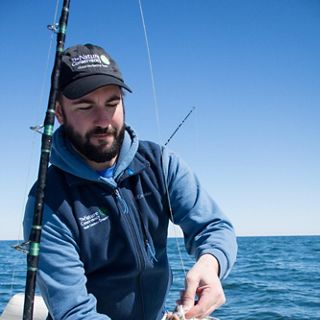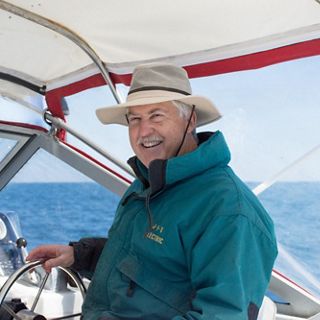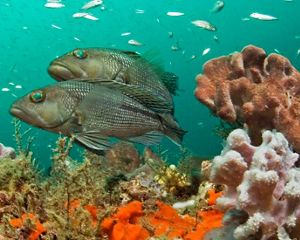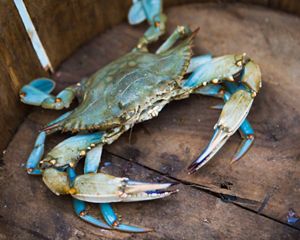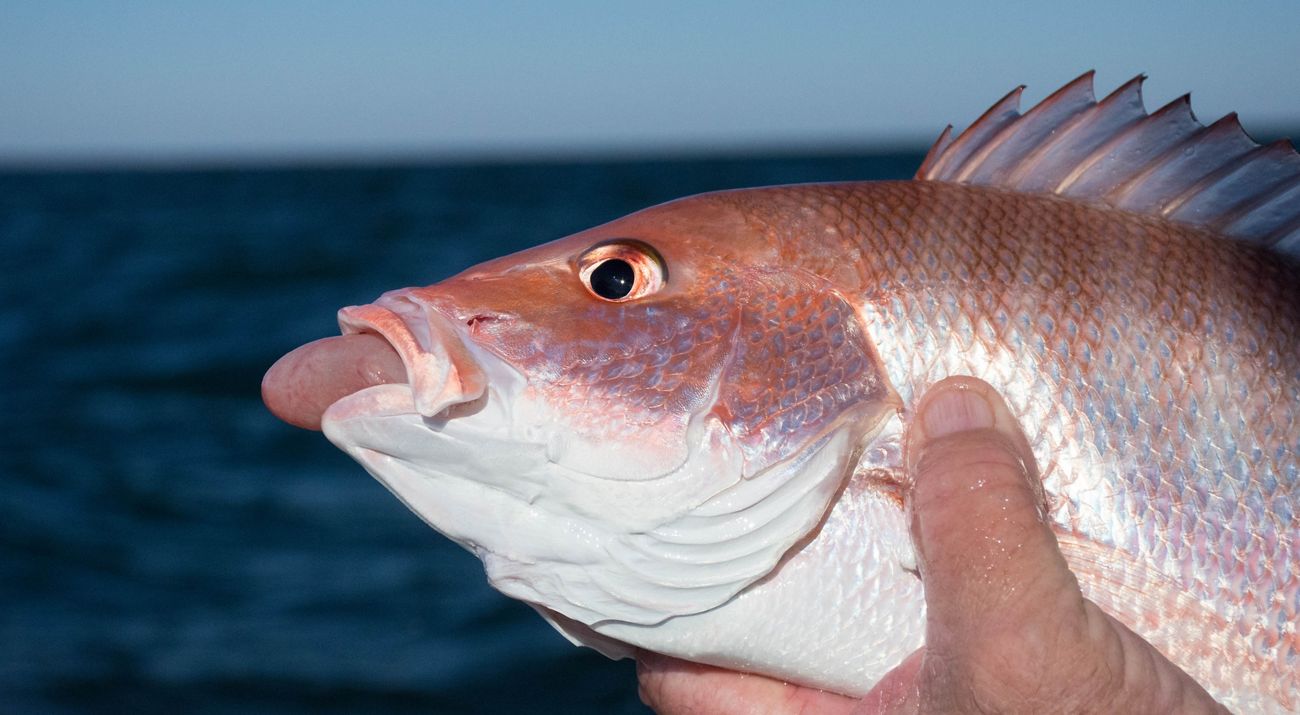
Fishing: Under Pressure
When just throwing back rare fish isn't enough, we're finding innovative solutions to save discarded fish from decompression sickness.
“We’ve got barotrauma!”
The cry cuts through the rumble of the engine and slapping of waves that earlier were the only sounds aboard Captain Warren Hupman’s Fishing Luhr. With the efficiency of an assembly-line worker, Hupman snaps a metal clip onto the lip of the red snapper that was just pulled aboard.
The fish doesn’t look good. Its eyes bulge wildly, and a large pink balloon protrudes from its open mouth.
Hupman slides out the baited hook, then attaches the clip and the fish to a rod. In less than a minute, the snapper is back in the water, descending rapidly on its own personal zip line. The clip reaches the ocean floor, and the fish swims free.
What is Barotrauma? When Fish Get the Bends
Barotrauma isn’t a new problem for deep-water fish. The word literally means pressure injury, and it’s a condition caused by the sudden change from a high-pressure, deep-water environment to a low-pressure, surface-water environment.
“So long as fishermen have been reeling up red snapper, gag grouper, black sea bass and other deep-water fish, some of those fish have suffered from decompression sickness,” says Bob Crimian, southeast ocean conservation specialist for The Nature Conservancy. “It’s like a diver getting the bends.’”
When a fish moves from high to low pressure too quickly, the compressed gas in its body expands, causing the stomach to stretch out of the mouth, eyes to bulge and bubbles to form in the heart and brain.
“Fish returned quickly to deep water shrink back to normal size and swim away,” says Crimian. “If they’re just thrown back, though, they float. These floaters often die from barotrauma or predators.”
Why Throwing Fish Back Is Not Enough
Unfortunately, red snapper caught locally must be thrown back most of the year. Red snapper season in the South Atlantic is extremely limited: In recent years, it’s been only a few days long. Before that, it sometimes didn’t open at all. A major contributor to this short season is discard mortality, or fish caught by accident that die after being returned to the ocean.
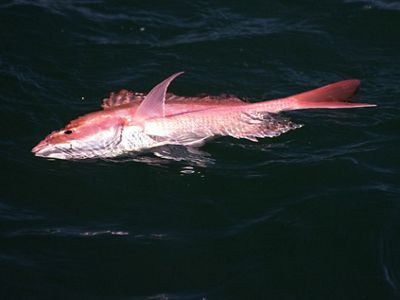
“It’s so frustrating for fishermen,” says Crimian. “They can’t keep what they catch, but throwing the fish back doesn’t help. Some years, the entire catch quota is used up by discarded fish that are assumed to have died after being released.”
Barotrauma is worst in summer, when the temperature difference is greatest between surface water and deep water.
“The fish that get barotrauma are the ones everyone wants to catch—the big ones,” says Hupman. “Summer is our peak fishing season, and it’s when those big fish suffer the most.”
Saving More Fish
Since fishermen can’t avoid accidental bycatch, TNC and other partners—including Gray’s Reef National Marine Sanctuary, Georgia Sea Grant, the South Atlantic Fishery Management Council and Georgia Department of Natural Resources—turned their attention to saving discarded fish.
Historically, fishermen used to treat barotrauma by venting, or deflating a swollen fish’s swim bladder with a large, hollow needle. It wasn’t an ideal solution.
“I’m no doctor,” says Hupman. “I didn’t like it, and my customers didn’t like it. The fish would leave a trail of blood. You didn’t feel like you were doing a good thing.”
Venting also is unreliable. When holding a thrashing fish, it’s all too easy to puncture a vital organ by mistake.
Saving Fish from Barotrauma
Fish descending devices can make a big difference in helping deep-sea fish recover from the trauma of depressurization. Click through the photos to learn how the process works.
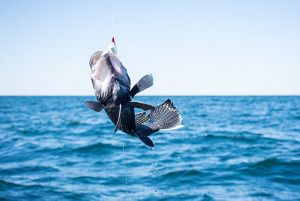
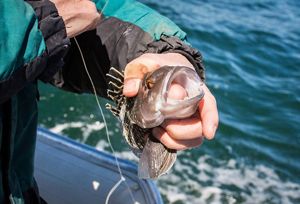
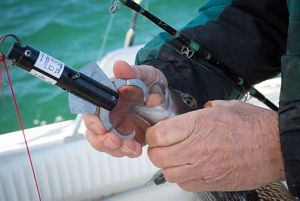

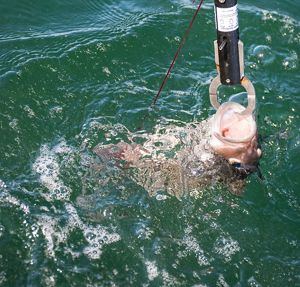

Black sea bass: Black sea bass are another popular deep-water fish that can suffer from barotrauma. © Cameron Rhodes

Barotrauma: The compressed gas in the fish’s blood and swim bladder expands when it’s brought to the surface, causing its stomach to distend and eyes to bulge. © Cameron Rhodes

Attaching device: Captain Hupman clamps the descending device to a distressed sea bass. © Cameron Rhodes

Back to sea: The sea bass is then lowered into the ocean via a rod attached to the device. © Cameron Rhodes

Headed safely home: Once the sea bass reaches a pre-set depth, the clamp will release and a re-pressurized fish will swim free. © Cameron Rhodes
Encouraging the Use of Descending Devices to Save Fish
When fish descending devices entered the market in the early 2010s, it was a big step forward. A fisherman latches the device onto a fish, then drops it via a fishing line. The device travels down to deep water, carrying the fish with it. Depending on the device, it either releases automatically at the appropriate water pressure or is released manually by the fisherman. Still, two big problems remained:
- Fishermen had to get devices and learn how to use them.
- Scientists needed data on the devices’ impact before they could influence fisheries management.
Thanks to a grant from the National Marine Sanctuary Foundation, TNC is on track to distribute 200 descending devices to charter captains and recreational fishermen in Georgia, such as Hupman, by the end of 2020. The initiative is part of TNC’s South Atlantic seascape program, which covers the waters off South Carolina, North Carolina, Georgia and Florida. TNC plans to expand the descending devices pilot across the region. The next step will be an orientation trip to South Carolina to teach fishermen there how to use the devices.
In exchange for receiving a free device, fishermen agree to attend a learning exchange that shares best fishing practices, then to report back on how they use the device. How many fish with barotrauma did they catch? Which species? Their answers will give scientists critical data on whether descending devices can help restore fish populations.
Collecting the data is an extra step, but it’s one that captains like Hupman are happy to take if it means fewer fish die.
“People have been really interested in and positive about the devices,” he says of his clients and fellow charter captains. “I tell them, ‘We’re going to use this to put the fish back so we can catch it again during season.’ They say, ‘That’s pretty cool.’”
Partnerships to Protect Fish
TNC and other partners are working with fishermen like Captain Warren Hupman to save deep-sea fish from barotrauma and to educate other fishermen and the public about best fishing practices. Click on the photos to learn more.
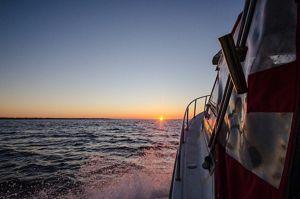
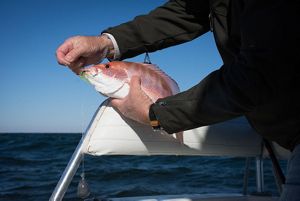
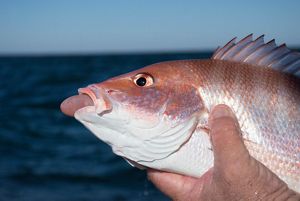
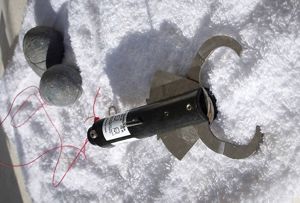
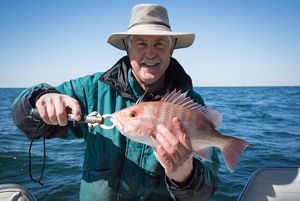

Ocean sunrise: Morning aboard Captain Warren Hupman’s Fishing Luhr, sailing out of St. Mary’s, Ga. © Cameron Rhodes

Red snapper: Red snapper are a popular deep-water fish with a very short season, due to a low population. © Cameron Rhodes

Barotrauma: A distended stomach coming out of a fish’s mouth is a sign of barotrauma, an injury caused by bringing fish rapidly from high pressure/deep water to low pressure/surface water © Cameron Rhodes

Fish descending device: A fish descending device, meant to return deep-water fish quickly to depth from a boat. © Cameron Rhodes

Captain Warren Hupman: Longtime charter captain Warren Hupman, who uses descending devices on his boat and makes a point of educating clients and fellow captains about their benefits. © Cameron Rhodes
Allowing Fishermen to Be Better Stewards
“Fishing is like Christmas morning,” says Hupman. “Until that fish breaks the water, you never know what could be at the end of that line.”
For many recreational fishermen, going out on the water is more about the experience than it is bringing home dinner. Making sure there are plenty of fish to catch—and re-catch—is just common sense.
“Fishing is what I love to do,” says Hupman. “I want there to be more fish so I can always come out here and fish. If I have grandkids someday, I want them to be able to come out here and fish.”
Support TNC’s South Atlantic seascape fisheries work by contacting Elizabeth Foster at 843-800-1274 or efoster@tnc.org.
